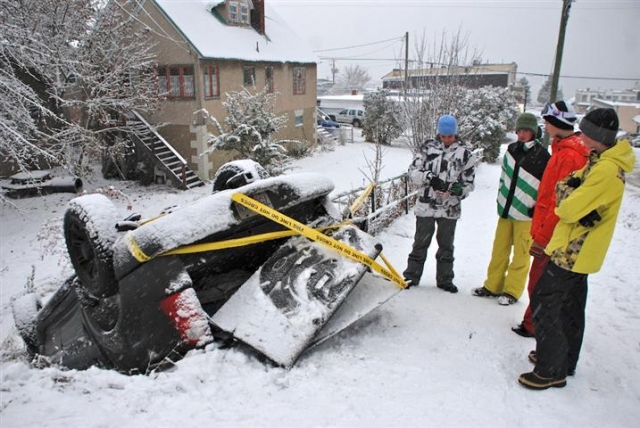Southern Interior drivers urged to adjust to fall and winter weather
Every year in October, an average of 28 people are injured or killed in crashes in the Southern Interior due to driving too fast for the conditions.
However, those numbers more than triple to 97 in December as driving conditions worsen.
Which is why ICBC has joined forces with police across the province to launch a speed awareness campaign urging drivers to prepare for the challenges of driving in the fall and winter and to adjust their driving to the road conditions.
“Safety is our top priority and we want Southern Interior drivers to be prepared for the rapidly changing weather conditions we experience at this time of year,” said Todd Stone, Minister of Transportation and Infrastructure.
“Whether it’s your daily commute or a trip out of town, give yourself extra travel time so you aren’t rushing and always check drivebc.ca before heading out so you can prepare for the road conditions you’ll encounter.”
“Even in the best conditions, driving requires your full attention,” said Suzanne Anton, Attorney General and Minister of Justice. “This is even more true when you’re on the roads in poor weather. When you drive too fast in wet, icy or snowy conditions, it’s harder to react to the unexpected.”
Seven out of 10 speed-related crashes in B.C. are caused by driving too fast for the road conditions, such as in rainy, icy or snowy weather. Throughout November, police and Speed Watch volunteers across B.C. are asking drivers to slow down and adjust their speed for the conditions.
“In the Southern Interior, drivers often encounter snow, ice and darker conditions at this time of year,” said Chief Constable Jamie Graham, Chair of the Traffic Safety Committee of the British Columbia Association of Chiefs of Police.
“Don’t be foolish and think that you don’t need to adjust your driving for the conditions. Slow down, increase your following distance and give yourself plenty of time to get to your destination. Posted speed limits are for ideal driving conditions only.”
“With the arrival of darker, poor weather at this time of year in the Southern Interior, it can be difficult for drivers to see pedestrians on the road,” said John Dickinson, ICBC’s director of road safety.
“Drivers need to keep a sharp eye out for others – especially at intersections, near transit stops and even on roads without sidewalks. Pedestrians need to do their part too – always make eye contact with drivers and never assume a driver has seen you.”
Here are tips to help you stay safe this fall and winter:
- When ice or snow hits: Ice and snow can hit unexpectedly. Early in the season, make sure your tires are rated for the conditions you may be driving in and check your tire pressure regularly – pressure drops in cold weather and overinflated tires can reduce gripping.
- Consider alternatives: When heavy winter conditions arrive, consider alternatives to help you get to work safely – take transit, work from home or adjust your hours of work to avoid rush hour traffic.
- If heavy rain hits: Heavy rain can seriously reduce visibility and make road surfaces more difficult to stop on. Make sure your wipers are in good condition and increase your following distance to at least four seconds so that you have time to stop if you need to.
- Planning a trip: If you’re travelling to an area you’re not familiar with, it’s important to check the road conditions for your entire route so you can prepare your vehicle for the weather you may encounter. Many highways in B.C. require drivers to use winter tires or chains from October 1 to April 30. Visit the Ministry of Transportation and Infrastructure’s website to see if they’re required for your route and learn how to properly use chains.

























Comments